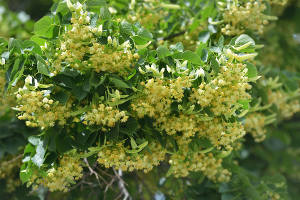

Its heart-shaped leaves have turned it into a symbol of love and faithfulness… But lime tree is more than anything an easy tree to grow, with rapid growth and refreshing shade.
If you have space in your garden, this is the ideal tree.
There are about fifty species of Tilia. The most common in Europe are T. platyphyllos, or large-leafed lime, T. cordata with small leaves, ubiquitous in forests, and T. x vulgaris, a hybrid of the first two, which best resists drought. In urban settings, silver lime (T. tomentosa) doesn’t fear pollution and was planted massively, but it has since been proven that its nectar was toxic for bees and bumblebees. Consequently, it isn’t recommended for gardens.
Lime tree is an easy tree to grow, and its rapid growth means you’ll quickly be able to bask in abundant shade. It resists dry spells and tolerates extremely mediocre soil types. This is a tree that has an extreme longevity: in Bavaria (Germany), a lime tree that is over 1000 years old still grows. It can reach 165 feet (50 m) tall. Its branches spread out and so it is important to designate a wide space for it to grow, and to plant it away from the house which would otherwise be covered in dark shade.

Incidentally, young lime tree or basswood leaves are edible and can be added to mixed salads. Dried and powdered, they produce protein-rich flour that was used during World War II. Lastly, honeydew produced by aphids on leaves when under attack (aphids often attack lime) and the nectar from large and small-leafed lime trees are excellent for bees.
Laure Hamann